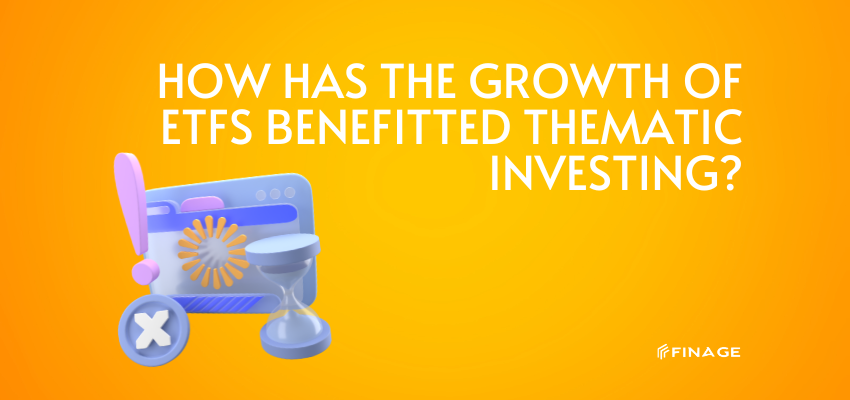How Has the Growth of ETFs Benefited Thematic Investing?
5 min read • November 26, 2024

Introduction
Over the past two decades, Exchange-Traded Funds (ETFs) have revolutionized the investment landscape, making diversified portfolios more accessible, affordable, and flexible for retail and institutional investors alike. Among the various strategies supported by ETFs, thematic investing has gained significant momentum, offering investors the opportunity to align their portfolios with specific trends, sectors, or ideas they believe in. Whether it’s renewable energy, artificial intelligence, or blockchain technology, thematic ETFs allow individuals to invest in narratives shaping the future.
The explosive growth of ETFs has amplified the popularity and feasibility of thematic investing. By providing liquidity, diversification, and cost efficiency, ETFs have become the ideal vehicle for investors seeking exposure to high-growth themes without the complexities of picking individual stocks. This article explores the connection between ETF growth and thematic investing, highlighting how ETFs have enhanced accessibility, expanded opportunities, and reshaped investor behavior.
Contents
- What is Thematic Investing?
- The Rise of ETFs: A Brief Overview
- How ETFs Have Supported Thematic Investing
1. Accessibility to Niche Markets
2. Diversification Across Themes
3. Cost Efficiency and Liquidity
4. Democratizing Investment in Emerging Trends
- The Impact of ETF Growth on Investor Behavior
- Challenges in Thematic Investing with ETFs
- Conclusion
What is Thematic Investing?
Thematic investing is an investment strategy that focuses on long-term trends or themes rather than traditional asset allocation based on sectors or geographies. Themes can be as diverse as:
Technological innovation (e.g., artificial intelligence, robotics, cloud computing)
Environmental sustainability (e.g., renewable energy, water management)
Social trends (e.g., aging populations, urbanization)
Thematic investors aim to capture the growth potential of these transformative trends by investing in companies that are well-positioned to benefit from them.
The Rise of ETFs: A Brief Overview
Exchange-Traded Funds (ETFs) were introduced in the 1990s as a way to provide investors with a cost-effective and flexible alternative to mutual funds. ETFs are investment funds that trade on stock exchanges, offering the benefits of diversification and transparency while being more liquid and accessible than traditional funds.
The growth of ETFs has been exponential, with global ETF assets under management (AUM) surpassing $10 trillion as of 2023. This growth has spurred innovation, leading to the creation of thematic ETFs that cater to investors interested in specific trends and ideas.
How ETFs Have Supported Thematic Investing
1. Accessibility to Niche Markets
Thematic investing often targets niche markets or emerging industries that may be difficult for individual investors to access through direct stock picking. ETFs bridge this gap by aggregating a basket of companies that align with a particular theme, allowing investors to gain exposure without needing in-depth expertise.
For example, an investor interested in renewable energy might struggle to identify and analyze the best-performing solar or wind energy companies. A thematic ETF focused on clean energy simplifies this process by bundling these companies into a single investment product.
2. Diversification Across Themes
One of the primary benefits of ETFs is diversification. Thematic ETFs spread investments across multiple companies within a theme, reducing the risk associated with relying on the performance of a single stock. This is particularly important in high-growth industries, where individual companies may face volatility or fail to deliver on their potential.
For instance, an ETF focused on artificial intelligence might include companies involved in software development, semiconductor manufacturing, and cloud infrastructure. This diversification ensures that investors are not overly exposed to one aspect of the theme.
3. Cost Efficiency and Liquidity
The growth of ETFs has made thematic investing more cost-effective. Traditional mutual funds often come with high fees and minimum investment requirements, making them less accessible to retail investors. In contrast, ETFs typically have lower expense ratios and can be traded like stocks, providing liquidity and flexibility.
Additionally, the liquidity of ETFs ensures that investors can enter or exit positions quickly without incurring significant costs, which is especially beneficial for those navigating fast-moving markets or high-growth themes.
4. Democratizing Investment in Emerging Trends
Before ETFs, investing in emerging trends was often limited to institutional investors with the resources and expertise to navigate niche markets. The advent of thematic ETFs has democratized access, allowing retail investors to participate in the growth of industries like blockchain, space exploration, and electric vehicles.
ETFs lower the barrier to entry by simplifying the investment process, enabling anyone with a brokerage account to align their portfolio with trends they are passionate about or believe in.
The Impact of ETF Growth on Investor Behavior
Thematic ETFs have not only made investing in specific trends easier but also reshaped investor behavior in several ways:
Increased Interest in Passive Investing: The simplicity and accessibility of ETFs have attracted more passive investors who prefer broad exposure to themes rather than actively managing individual stocks.
Focus on Long-Term Trends: Thematic ETFs encourage investors to think long-term by aligning their portfolios with megatrends that are expected to drive growth over decades.
Diversification Beyond Traditional Sectors: Investors are increasingly looking beyond traditional sectors and geographies to themes that cut across industries and regions.
Challenges in Thematic Investing with ETFs
While thematic ETFs offer numerous benefits, they also come with challenges:
Theme Viability: Not all themes are sustainable or profitable in the long run. Some may lose relevance or fail to deliver expected growth, leading to underperformance.
Concentration Risk: Despite diversification within the ETF, thematic ETFs are inherently concentrated in a single trend, which may expose investors to higher risks compared to broad-market ETFs.
High Volatility: Many thematic ETFs focus on high-growth industries, which can experience significant price swings.
Overcrowding: Popular themes can lead to overcrowding, where too many investors pile into the same ETFs, potentially inflating valuations.
Conclusion
The growth of ETFs has profoundly benefited thematic investing by providing accessibility, diversification, and cost efficiency. These innovative financial instruments have democratized access to high-growth trends, allowing both retail and institutional investors to align their portfolios with transformative themes shaping the future. From artificial intelligence to renewable energy, ETFs make it easier than ever to invest in ideas that resonate with personal values and long-term growth prospects.
However, thematic investors must approach these opportunities with caution, considering the risks of concentration, volatility, and theme viability. By carefully evaluating their investment goals and the underlying dynamics of their chosen themes, investors can leverage the growth of ETFs to build portfolios that are not only aligned with their vision for the future but also resilient in the face of market challenges.
The combination of ETFs and thematic investing underscores the evolution of modern finance, where innovation meets accessibility, empowering a broader audience to participate in shaping tomorrow’s world.
You can get your CFDs ETFs Market Data with an API key.
Build with us today!
Claim Your Free API Key Today
Access stock, forex and crypto market data with a free API key—no credit card required.

Stay Informed, Stay Ahead
Finage Blog: Data-Driven Insights & Ideas
Discover company news, announcements, updates, guides and more
.png)
.png)
.png)